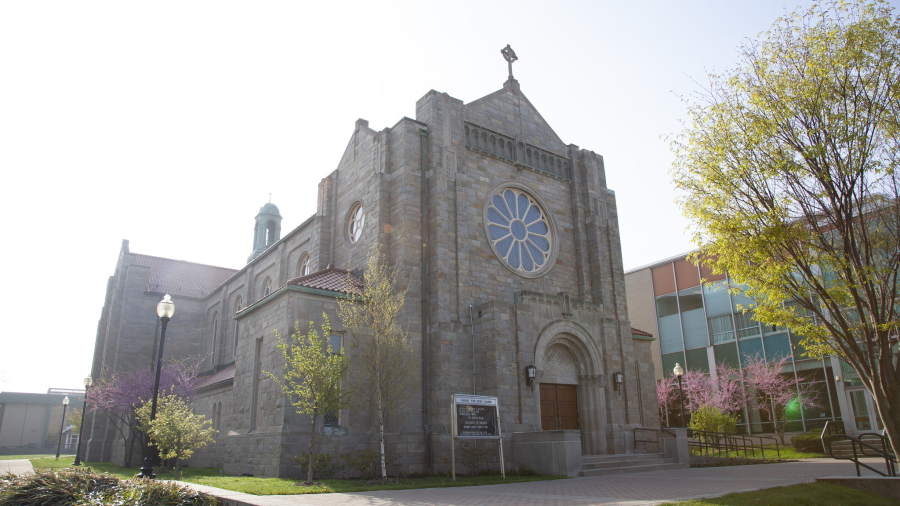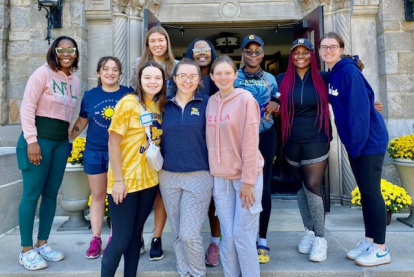Our Mission
We are an intentional Catholic Faith Community formed in the Jesuit tradition and guided by Ignatian spirituality. We welcome and we embrace all of God’s people. With prayer, worship and a discerning spirit, we journey to discover what God is calling us to be.
Christ the King Chapel
The historic Christ the King Chapel, located on the Canisius University Campus, is our worship center and our spiritual home. All people of all faith backgrounds are welcome to join us for worship, prayer and community. The Chapel is generally open from morning to night. All are welcome to visit, rest, pray and discern their relationship with God in our Chapel. Groups are welcome to gather in the Chapel for many types of community events by contacting our staff.
Our Staff
Fr. Frederick G. Betti, S.J. Chaplain
Office: 716-888-2875 / Cell: 716-572-8377
@email
Deacon Gary Andelora, Sacramental Minister/ Faith Formation
Office: 716-888-2425
Masses, Liturgies and Sacrament Celebrations
Faith Community Liturgies continue throughout the year and are not limited to the Academic schedule of the University. Adjustments will be announced.
Mass Schedule
Sunday Masses
- 9:30am
- 7:00pm
Campus Mass - 7:00 PM
Christ the King Chapel
Weekday Masses in Christ the King Chapel
- Monday-Friday 12:05 PM
Confessions
- Monday and Friday 11:00 - 12 (or by appt. if arranged with staff)
Friday Devotions
- Adoration 11-12
- Sacred Heart Prayers after the 12:05 Mass
- Anointing of the Sick after Mass
Communion Calls: Contact Fr. Betti
Mass Intentions: for weekday and Sunday Masses may be arranged by contacting Fr. Betti
Memorial Masses: Contact Fr. Betti
Weddings in the Chapel: The Sacrament of Marriage in the Roman Catholic Rite only may be celebrated in the Chapel. For requirements, schedules and other details please contact Deacon Gary Andelora @ 716-888-2425,
Baptisms: Please contact Fr. Betti to arrange for the celebration of this Sacrament of Initiation.
Joining Our Faith Community: All are welcome to join us for our Masses, prayer and liturgies. If you wish to register to join our community and receive regular notifications please contact Fr. Betti or pick up a registration form in the Chapel on our community info table.
Getting Involved in the Community: We welcome the participation of our community in celebrating our worship services. We welcome lectors, trained ministers of the Eucharist, Hospitality Ministers, social event helpers, musicians, vocalists, Chapel care cleaners etc. For more information speak to Fr. Betti after our Masses or contact him in the office.
Stewardship: We are grateful for and depend on the generosity of our community. Free Will collections are taken at our Sunday Masses. Envelopes are also provided at the doors of the Chapel. If you wish to have your weekly donations recorded please indicate this on our envelopes.
Seasonal, One time or planned giving may be discussed with Fr. Betti.
Calendar of Events
October
10/3: St. Francis Day Blessing of the Pets 1:00 PM outside the Chapel
10/5: St. Francis Day Blessing of the Pets after the 9:30 Am Mass outside the Chapel
10/6: Ecumenical Prayers for Peace 12:45 PM outside the Chapel at the Peace Pole.
November
11/2: ALL SOULS REMEMBRANCE at the SUNDAY 9:30 Mass . Alumni, family and friends of all Jesuit schools are welcome to join us. Special welcome to the members of the Demske Society. Please submit names for our Remembrance Trees by October 27th to Fr. Betti
11/27: THANKSGIVING DAY MASS at 9:30 AM light reception to follow
No 12:05 daily Mass All Alumni family and friends are welcome to join our community Light reception to follow
11/30: FIRST SUNDAY OF ADVENT with Blessing and Lighting of Advent Wreath at 9:30 and 7:00 Masses and Blessing of the Campus Manger
December
12/7: SECOND SUNDAY OF ADVENT w Blessing of Students for Exams at 9:30 and 7:00 Masses
12/8: Solemnity of the Immaculate Conception Masses at 12:05 and 5:15 PM
12/14: THIRD SUNDAY OF ADVENT w Bambinelli Sunday; Blessing of the Infant Jesus Manger statues, straw and Polish Wafers at both 9:30 and 7:00 Masses
12/21: FOURTH SUNDAY OF ADVENT Masses at 9:30 and 7:00
12/24:CHRISTMAS EVE FAMILY MASS AT 4:00 PM Childrens' nativity procession. All families, alumni, friends in WNY for Holidays are welcome!
12/25: CHRISTMAS DAY MASS 9:30 AM (no 7:00 PM MASS)
JANUARY:
1/1/2026: SOLEMNITY OF MARY, THE MOTHER OF GOD. MASS AT 9:30 AM
(no 7:00 PM MASS)




